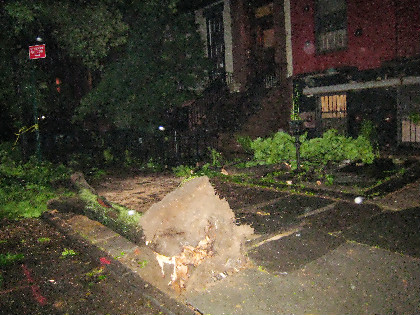While the tree carnage of ten days ago was spectacular, brisk winds tonight claimed another victim. BHB friend Martin L. Schneider, perhaps channeling Edward Bulwer-Lytton, sends the following, along with the photo above:
It was a dark and stormy night. And this was the shocking scene on Monroe Place at the Clark Street corner around 9:30 p.m., Tuesday. Our daughter, Carla Muskat, was in the front room in number 12, quietly reading. A New Hampshire person, she heard a familiar sound, that of a tree breaking apart in a windy gust. About 15 minutes later, she heard the sound of a chain saw and knew then that it was bigger than a branch. The entire tree had been uprooted, hurting nobody, but falling down on [the] stoop at number 3. Luckily, no damage was done. Just a lot of out-of-place greenery in the gutter and a rotted out tree bottom fully exposed. And, one more tree pit to get filled in with something fresh and healthy.



